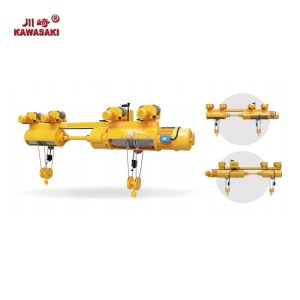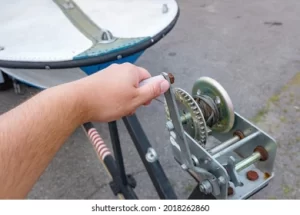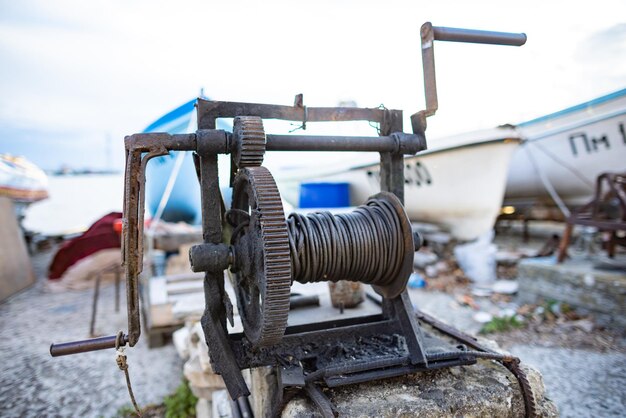Understanding the Basics of a Hand Winch
What is a Hand Winch?
A hand winch is a mechanical device designed to pull or lift heavy objects with the help of a crank or lever system. It’s powered by human effort rather than an external power source, making it a versatile tool for tasks such as towing, loading, and securing various loads. Hand winches feature a spool around which a load-bearing cable or rope wraps, enabling users to exert substantial pulling force by turning the winch handle.
Different Types of Hand Winches
Hand winches come in several configurations. The most common types include the lever-operated winch, which allows for flexible movement, and the standard hand crank winch, which is straightforward and efficient for simple tasks. Some models feature a ratchet mechanism to prevent the load from unwinding unintentionally, while others offer higher capacities for demanding lifting tasks. Understanding these options will help you select the right type of hand winch suitable for your specific needs.
Preparing for Installation
Tools and Materials You’ll Need
Before trying to install a hand winch on your trailer, gather the necessary tools and materials. Essential items include a wrench set, drill, screws, bolts, and a level for alignment purposes. Be sure to have the hand winch itself ready, along with any specified mounting hardware or brackets included by the manufacturer. Having all these items on hand will streamline the installation process.
Safety Precautions to Follow
Safety should be your top priority when installing a hand winch. Always wear appropriate personal protective equipment (PPE), including gloves and safety goggles, to prevent injuries. Make sure the area around the trailer is free from debris and other hazards that could cause accidents. Moreover, ensure the trailer is properly stabilized and secured during the installation to avoid any movement that could complicate your work.
Selecting the Right Location on the Trailer
Selecting the appropriate location on the trailer for mounting your hand winch is crucial for seamless operation. The winch should be positioned where the load will be applied so that pulling or lifting is efficient and safe. Consider the design and structural integrity of the trailer to find a strong mounting surface. The winch should also be easily accessible, allowing the operator to crank it without obstructions while providing a good line of sight to handle the load.
Step-by-Step Installation Guide
Positioning and Aligning the Winch
Begin the installation process by positioning the hand winch over the pre-selected area of your trailer. Use a level to ensure that it is aligned correctly and straight. Misalignment can lead to uneven loading or increased strain on the winch. Once you have achieved the proper position, mark the drill holes for the base of the winch with a pencil or marker to facilitate accurate drilling.
Securing the Winch to the Trailer
With your holes marked, it’s time to drill into the trailer’s surface carefully. Ensure that the drill bits match the screws or bolts you’re using for mounting. After drilling, align the winch again, placing the base over the holes. Secure the winch by tightening the screws or bolts, ensuring a firm connection that can withstand the stress during operation. Once securely mounted, attach the cable or rope according to the manufacturer’s instructions and ensure everything is functioning properly.
Incorporating a Kawasaki hand winch, such as the JC-E model from Apollo, can elevate your installation experience. Known for its high durability and performance, the Kawasaki hand winch features a seamless design that allows for both manual operation and versatility in various settings. The ingenious mechanism reduces operational strain and enhances safety during use. Additionally, consider these handy tips for optimal usage: always check the winch for wear and tear, lubricate moving parts, and adhere to the manufacturer’s weight limits for consistent performance.

By following this expert guide on installing a hand winch, you can ensure a safe, efficient, and effective setup on your trailer, ready to tackle any heavy lifting or towing tasks.
Running Cables or Straps on Your Hand Winch
Installing Cable on Brake Winches
When installing a cable on a brake winch, it is essential to start by ensuring that the winch is level and securely mounted to the trailer. The winch spool should be free of any obstructions to allow for smooth operation. Begin by feeding the cable through the designated slot or guide, ensuring that it wraps around the spool in the correct direction, which is typically indicated by arrows or markings on the winch itself. Once the cable is fed through, carefully adjusting the tension while ensuring there are no twists or knots in the cable is crucial to prevent any complications during operation.
Pay special attention to the connection points, as they play a critical role in ensuring the cable remains secure during use. Attach the end of the cable to a rated hook or latch mechanism that is securely fastened to the winch. It is advisable to double-check that the cable is not frayed, as this could lead to failure during heavy lifting. After installation, perform a manual rotation of the winch to verify that it operates smoothly without any binding or grinding noises.
Attaching and Tensioning Straps Correctly
In cases where straps rather than cables are used, the methodology remains similar, with a focus on correct positioning and tension management. Start by threading the strap through any designated slots on the winch anchorage or roller guide, making sure it is aligned properly before securing it. The strap should be arranged to minimize twisting, which can lead to wear and eventual failure. Use the provided ratchet mechanism to tighten the strap, ensuring a firm grip on the load without over-tensioning, as this could damage the material or the mechanism itself.
Moreover, always verify that the load is evenly distributed and securely held before engaging the winch. The winch should be operated in a steady and controlled manner to prevent jerking motions that could strain both the winch and the strap. Following the manufacturer’s guidance for strap load ratings and installations is paramount for the safety and effectiveness of the operation. Regularly inspect the strap for signs of wear and maintain the mechanism to ensure reliability over time.
Finalizing and Testing the Installation
Verifying Secure Connection
Upon completing the installation of your hand winch, it is important to thoroughly check all connections and mounting points. Inspect the winch to ensure that all bolts and screws connecting it to the trailer are tight and that there are no loose parts. Turning the winch handle manually should feel smooth, indicating no binding in the mechanism. Additionally, examine the cable or strap connections to ensure they are secure and free from any signs of fraying or damage inherent to long-term use.

A successful verification process includes a complete visual inspection of the entire winching system. This involves checking the integrity of the trailer surface around the winch for any cracks or signs of stress that could indicate faulty installation. Ensure the winch handle operates freely and that the release mechanism functions correctly. Addressing any discrepancies before testing under load can prevent potential accidents or failures during operation.
Functional Testing Procedures
After verifying the secure connection, the next step is to perform comprehensive functional testing procedures. Begin by attaching a test load within the winch’s rated capacity to ascertain operational integrity. Gradually engage the winch to lift the load slowly while monitoring the system for any irregular noises or actions. Keep an eye on the winch’s braking action, ensuring the load remains steady and does not slip.
Once the initial lift is successful, conduct a few cycles of lifting and lowering the test load to ensure reliability. This process helps in identifying any operational issues, including the likelihood of cable slippage or strap failure under load conditions. Expanding upon this, it is encouraged to carry out a final inspection post-test to ensure that no components have been stressed beyond their limits. Regular maintenance, including lubrication and cleaning of the winch, will also enhance its lifespan and ensure optimal performance for any future tasks.
Handy Tips for Optimal Usage
Maintenance Tips for Longevity
To ensure the longevity of your hand winch, regular maintenance is essential. Inspect the winch frequently for signs of wear and tear; this includes checking the cable or strap condition to prevent unexpected failures during operation. Lubrication plays a vital role in maintaining smooth functionality, so periodically apply a suitable lubricant to the winch’s moving parts, particularly the ratchet mechanism and handle pivots. Additionally, make sure to clean the winch after each use to remove dirt, debris, and corrosive materials that could hinder performance or lead to rust over time.
It’s also important to store your hand winch properly when not in use. Keep it in a dry environment away from moisture, which can lead to rust and degradation of materials. Using protective covers can further shield the winch from dust, dirt, and other pollutants, prolonging its life. Regularly consulting the manufacturer’s maintenance guidelines will ensure that you are using the proper products and techniques, helping to maximize the performance and reliability of your hand winch for all future tasks.
Common Problems and Their Fixes
Various issues may arise when using a hand winch, but many can be resolved quickly with the right approach. One common problem is improper cable winding, which can cause tangles and operational failures. If you notice that the cable is unevenly distributed on the spool, stop using the winch and rectify the situation by unwinding the cable, ensuring it is rewound evenly. Always verify that the cable or strap is free from knots before use to prevent obstruction during operation.
Another frequent concern involves the winch not engaging or disengaging properly. This can often be attributed to dirt buildup affecting the ratchet mechanism. In such cases, cleaning the mechanism and applying lubricant can restore proper functionality. It’s crucial to check the load limits of your winch to prevent overloading, which can lead to bending or breakage of components. Understanding these common problems and their solutions not only enhances safety but also ensures that you can rely on your hand winch effectively.
Additional Resources
Frequently Asked Questions About Hand Winches
When considering hand winches, several frequently asked questions arise among users. One common inquiry is about the weight tolerance of hand winches. Typically, each winch is rated for a specific load capacity, which should be indicated by the manufacturer. Always adhere to these ratings, as exceeding them can cause catastrophic failures.
Another question often posed is the differences between manual and electric winches. While electric winches may offer greater convenience and power, manual winches like those from Kawasaki provide dependable performance without the need for electrical sources. Users may also ask how to best secure loads, which involves ensuring that cables or straps are tightly wound and that hooks are made from robust materials specifically designed for heavy loads. By addressing these FAQs, users can gain a more comprehensive understanding of hand winches and their operational capacities, enhancing overall usage efficiency.
Useful Video Tutorials and Guides
For those seeking to deepen their knowledge and expertise on hand winches, many video tutorials and guides are available online. These resources often provide visual demonstrations of proper installation techniques, maintenance routines, and operational best practices. Watching videos can help users visualize the step-by-step processes discussed in text guides, providing clear examples of potential challenges and solutions. Additionally, manufacturers such as Kawasaki may offer specific video content detailing the features and applications of their hand winches, including models like the JC-E, which can enhance understanding of their products.
Furthermore, many online platforms feature user-generated content where individuals share their hands-on experiences and tips regarding hand winch use. Engaging with these communities can foster learning through shared insights and troubleshooting tips. These resources serve as invaluable tools for both novice and experienced users, promoting effective and safe winch operation while enhancing overall confidence in utilizing this essential equipment.

